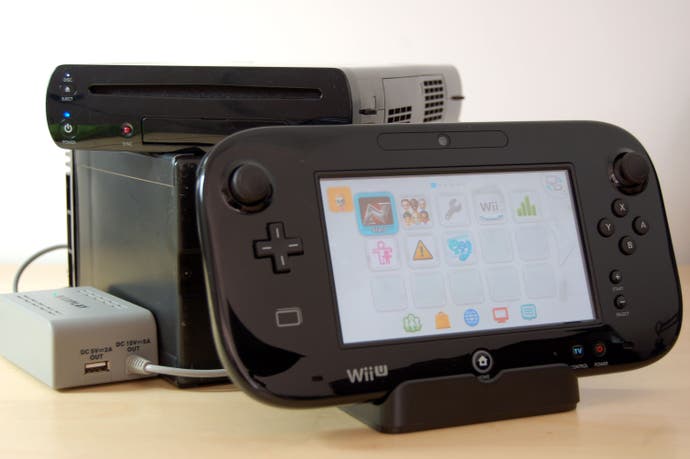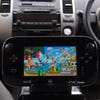Wii U goes mobile
Take your console on the road for under ?20. Plus: Digital Foundry explores the possibilities of a fully battery powered console.
There are three things we really like about the Wii U hardware here at Digital Foundry - its diminutive dimensions, the GamePad controller and its extremely low power draw. Nintendo's new console is the paragon of efficiency, producing current-gen visuals using less than half the power of the Xbox 360 or PS3 running the same games. It's small enough to pack into a travel bag, and its battery-powered controller means you can game on the move without requiring a bespoke display. All of which leads us to wonder - could Wii U actually be viable as a mobile games system?
Of course, there are far more user-friendly, mobile-specific solutions out there - Nintendo's own 3DS, the PlayStation Vita or iOS/Android tablets for example. But the fact is that even the most forward-looking mobile graphics tech is a good year away from matching Xbox 360/PS3/Wii U quality and even then, it'll still take a while for game-makers to utilise that technology. And by that point, you still won't be playing Nintendo console games on them, nor will there be a surfeit of titles as ambitious as, say, Assassin's Creed 3 or Need for Speed: Most Wanted - just a couple of the games that work very well indeed on Nintendo's new console. There's a value angle to this too in that you're using the exact same console hardware you have at home - so there's no need to buy a new device. To match or exceed Wii U game quality, you'd need to buy a gaming laptop, which isn't that much more portable, and costs anything from £500 upwards.
The notion of playing Wii U outside of the home is nothing new of course. Right from the launch of the console, gamers realised that the machine had plenty of mobile potential - as long as you were within reach of a power point. Wii U gameplay on the train, or in a business class seat on a flight? No problem. Well now we can add the car to the list of venues with the release of the new MaxPlay adaptor - a replacement Wii U power supply that plugs directly into the cigarette lighter power-point on any car.
The device itself is nothing spectacular in terms of design and there's a bit of a "low rent" feel to it, particularly in terms of the branding, but there's clearly been a bit of thought put into the functionality of the device. The 12v output of the car battery is transformed into the 15v, 5A power input the Wii U requires, and there's also an additional USB 5v charging slot built into the design so you can recharge the GamePad while on the move too, completely removing the need to pack a second power supply into your travel bag. From there on out, MaxPlay works exactly as you would hope it to, providing all the power required for the Wii U to work flawlessly while on those long car journeys.
Now, the chances are you have questions and suspicions about the viability of this device. We did too. First of all, there's no real guarantee on the level of power you're going to get from any car battery, because voltages vary significantly - far more than they would from a mains power point. Well, you can rest easy here. MaxPlay has a voltage regulator that ensures you're getting a clean 15v output regardless of the variation in the input. We compared output from the device to the standard Wii U PSU and got the same, locked 15 volts.
You might also have issues about putting a 33W load onto the car battery using an interface most often used for low-power phone chargers and sat navs. This shouldn't be a problem really - assuming you're actually in motion, the car engine will be constantly topping up the battery to an extent that easily accommodates the power draw taken up by the console. It's not a particularly good idea to game for prolonged sessions with the engine off, but even if you did, you'd still need to play for several hours to put any kind of dent into the capacity of a standard car battery.
Next up, there's the fact that the Wii U itself isn't designed to be played in a mobile environment. Bumps in the road could jar the device and scratch the disc, for example. It's potentially an issue but if you're not playing in a car with a hard suspension set-up like a Lotus Elise and that the console is on a soft seat rather than a hard floor, the chances are you'll be absolutely fine. We certainly had no issues of this kind in our testing, but equally, it's safe to say that we wouldn't be getting any official endorsements from Nintendo for this kind of non-standard gaming behaviour.
"Wii U draws less power than many gaming laptops - the MaxPlay adaptor is pretty neat but a bespoke battery to make it fully portable would be even cooler."

But can the Wii U cross the final mobile frontier? Could the machine be run entirely from battery? By our estimation, it's definitely possible. Indeed, we knocked up our own proof of concept using the MaxPlay connected to the auxiliary battery from a Toyota Prius. It's not a particularly elegant, lightweight or space-efficient solution (the Prius battery is a scaled-down version of a standard car battery - most of the juice that car needs comes from the main hybrid cells) but you won't be short of battery life - by our calculations, you could run the console for at least eight hours with this lash-up. Downscale the battery, utilise something like lithium polymer cells and we may well have a winner. The Alienware M18x battery is rated for 96 watt hours at 14.8 volts - a set-up that would give you close to three hours for Wii U gaming. The concept of independently chargeable universal laptop batteries is nothing new so it's definitely possible.
It all comes back to the low 33W power draw. That's significantly lower than most gaming laptops (when they're actually gaming) - a state of affairs helped immensely by the fact that the Wii U has no in-build display to run, a component that accounts for much of the power requirement on mobile devices. So the question isn't really whether you can run a Wii U from battery, it's more about how expensive it would be to create a device that does the job and would last more than a couple of hours - a challenge common to gaming laptops which often have trouble yielding anything over an hour of intense gaming.
In the meantime, we had a lot of fun testing out the Wii U outside of its home-based comfort zone. We aren't disputing the place of 3DS, Vita, phones or tablets in the gaming arena, nor are we suggesting that this is anything like an actual replacement. However, the phrase "console quality graphics" is often bandied about by mobile GPU vendors and game-makers and actually being able to play proper AAA console games on the move only serves to demonstrate just how much of a gulf remains between mobile and current-gen titles. When decent gaming laptops start at £500 (the going rate for the Nvidia Kepler-powered Acer Aspire Ultra M3), the notion of spending £19 on the MaxPlay and taking your existing console hardware with you seems like a rather good deal - and as a way to keep the kids occupied during a long-haul car journey, it's a great little product.




